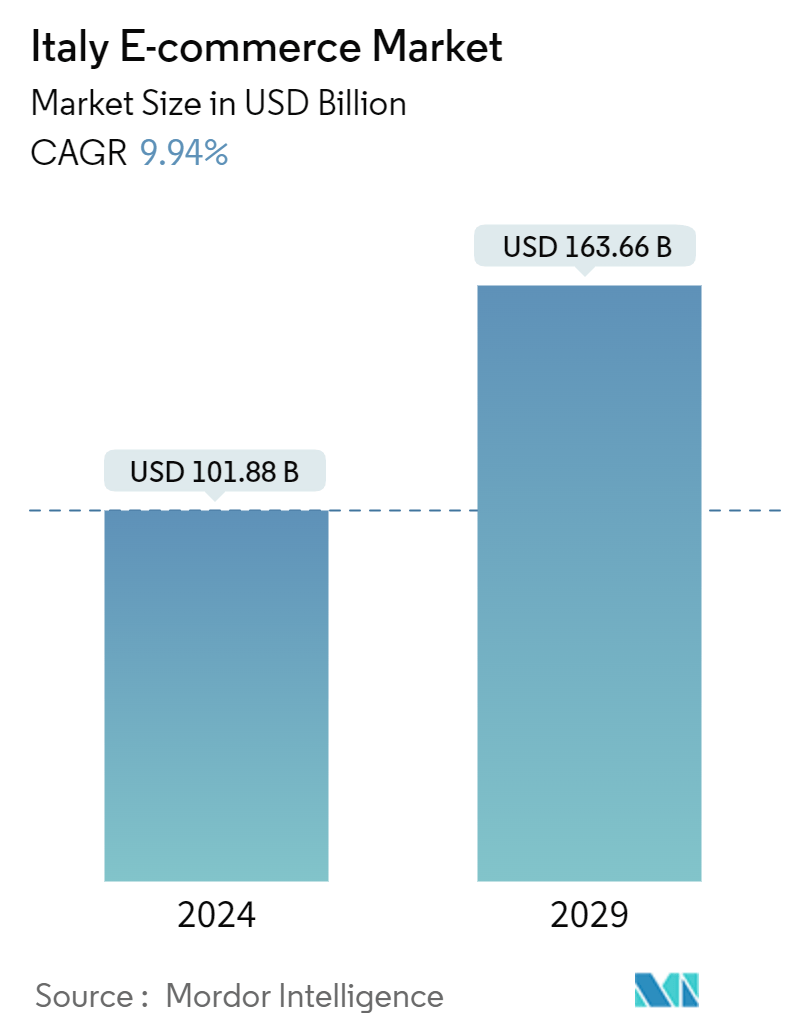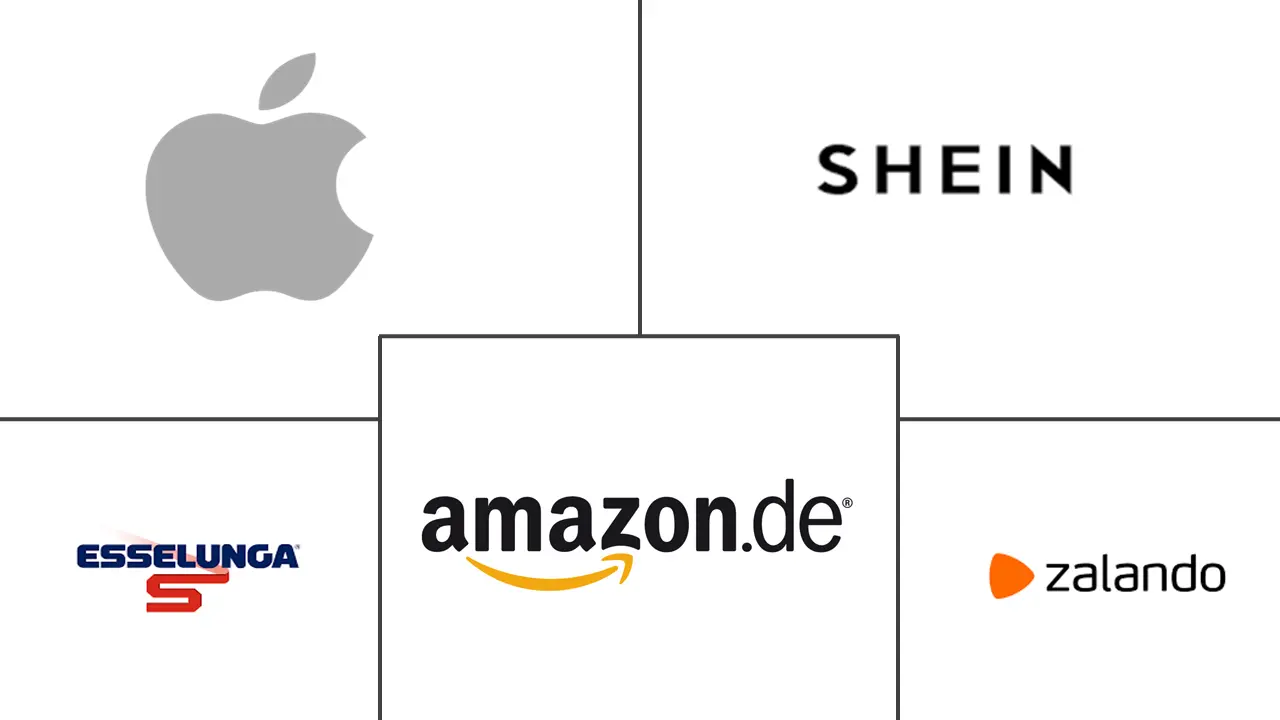Market Size of Italy E-commerce Industry

| Study Period | 2019 - 2029 |
| Base Year For Estimation | 2023 |
| Market Size (2024) | USD 101.88 Billion |
| Market Size (2029) | USD 163.66 Billion |
| CAGR (2024 - 2029) | 9.94 % |
| Market Concentration | Medium |
Major Players
*Disclaimer: Major Players sorted in no particular order |
Italy E-commerce Market Analysis
The Italy E-commerce Market size is estimated at USD 101.88 billion in 2024, and is expected to reach USD 163.66 billion by 2029, growing at a CAGR of 9.94% during the forecast period (2024-2029).
Technological advances have made business communication faster, easier, less expensive, and more efficient. It has enabled the company to move from the domestic to the global market. Furthermore, the growing popularity of cybercafés has played an essential role in attracting internet users to e-commerce.
- International B2C retailing platforms heavily influence the Italian e-commerce market. Subito, Aliexpress, Zalando, Autoscout24, Groupon, Yoox, and Pixmania are some of the most popular e-commerce websites in Italy. ePrice and Saldiprivati are owned by Banzai Srl, Italy's largest e-commerce company.
- E-business is the most common model in e-commerce, which entails digitalizing corporate processes in collaboration with clients and suppliers. Furthermore, in recent years, web portals for B2B e-commerce (similar to e-commerce B2C models) and B2B marketplaces have grown in popularity. Automotive, pharmaceutical, consumer goods, and electronics are the most active sectors implementing B2-B solutions.
- The COVID-19 pandemic has forced many small businesses to rethink their decades-old business models or face permanent closure. New and existing technologies are being pushed to the forefront of every business toolkit. Forward-thinking companies are addressing talent issues arising from these new digital business skillsets.
- The COVID-19 pandemic is undergoing rapid digital transformation, and many Italian companies prioritize digitalization. Furthermore, the requirement for private and state-owned businesses to submit electronic invoices to the Italian Public Administration (PA) has pushed for digitalization.
Italy E-commerce Industry Segmentation
E-commerce is the purchasing and selling of products and services over the Internet. It is conducted over computers, mobiles, tablets, and other smart devices. There are primarily two types of e-commerce, including Business-to-Consumer (B2C) and Business-to-Business (B2B).
The Italy E-commerce Market is segmented into B2C E-Commerce (Beauty and Personal Care, Consumer Electronics, Fashion and Apparel, Food and Beverage, Furniture and Home), and B2B E-Commerce.
| By B2C E-commerce | ||||||||
| Market size (GMV) for the period of 2017-2027 | ||||||||
|
| By B2B E-commerce | |
| Market size for the period of 2017-2027 |
Italy E-commerce Market Size Summary
The Italian e-commerce market is experiencing significant growth, driven by technological advancements and the increasing adoption of digital business models. The shift from traditional retail to online platforms has been accelerated by the COVID-19 pandemic, which prompted many businesses to embrace digital transformation to survive. This transition has been supported by improved internet infrastructure and the widespread use of mobile devices for online shopping. The market is heavily influenced by international B2C retailing platforms, with major players like Amazon, Shein, and Esselunga leading the charge. The fashion industry, once the dominant force, is now complemented by the electronics and media sectors, which have become substantial contributors to e-commerce revenue in Italy.
The expansion of e-commerce in Italy is also reflected in the growing number of online shoppers and the increasing integration of social media with e-commerce platforms. This trend has made it easier for consumers to connect with brands and make purchases directly through social media channels. The Italian government's initiatives, such as the National Recovery and Resilience Plan, are further promoting digitalization and innovation within the economy. As a result, companies are not only enhancing their online presence but also investing in new technologies to improve efficiency and customer engagement. The market's growth is expected to continue, with e-commerce becoming an integral part of Italy's economic landscape.
Italy E-commerce Market Size - Table of Contents
-
1. MARKET INSIGHTS
-
1.1 Market Overview
-
1.2 Industry Attractiveness-Porter's Five Forces Analysis
-
1.2.1 Bargaining Power of Suppliers
-
1.2.2 Bargaining Power of Buyers/Consumers
-
1.2.3 Threat of New Entrants
-
1.2.4 Threat of Substitute Products
-
1.2.5 Intensity of Competitive Rivalry
-
-
1.3 Key market trends and share of E-commerce of total Retail sector
-
1.4 Impact of COVID-19 on the E-commerce sales
-
-
2. Market Segmentation
-
2.1 By B2C E-commerce
-
2.1.1 Market size (GMV) for the period of 2017-2027
-
2.1.2 Market Segmentation - by Application
-
2.1.2.1 Beauty & Personal Care
-
2.1.2.2 Consumer Electronics
-
2.1.2.3 Fashion & Apparel
-
2.1.2.4 Food & Beverage
-
2.1.2.5 Furniture & Home
-
2.1.2.6 Others (Toys, DIY, Media, etc.)
-
-
-
2.2 By B2B E-commerce
-
2.2.1 Market size for the period of 2017-2027
-
-
Italy E-commerce Market Size FAQs
How big is the Italy E-commerce Market?
The Italy E-commerce Market size is expected to reach USD 101.88 billion in 2024 and grow at a CAGR of 9.94% to reach USD 163.66 billion by 2029.
What is the current Italy E-commerce Market size?
In 2024, the Italy E-commerce Market size is expected to reach USD 101.88 billion.

